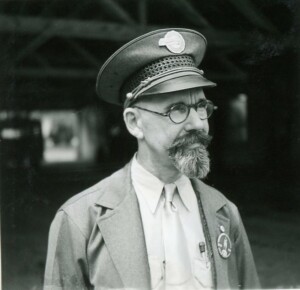
Riley Robertson, Oregon Motor Stages Employee showcasing whiskers grown for Salem Centennial Celebration in 1940. WHC Collections 1995.015.0018
Bus Drivers and Whiskerinos – a snapshot of 1940 Salem
We’re not supposed to have favorites, but sometimes a collection comes along that you can’t help but be a little partial towards. Such is the case for me with a stack of 22 black and white 2”x2” snapshots collected by streetcar operator-turned-bus driver Pryor Robertson during the 1940 Salem Centennial Celebration. The candid portraits of his coworkers feel so relatable despite being 81 years old. Even through the black and white tones, there is nothing to differentiate the faces of these men from those you might meet on the street today or on someone’s social media feed. One of those touchstones of time travel. You can see the collection here.
Salem’s Centennial
1940 was the year the city decided to celebrate it’s hundredth birthday. We’ll overlook the fact that the date was a bit arbitrary — the city’s charter wouldn’t come through until 1857[1] and you might rightly point out the important fact that the Kalapuya people calling Chemeketa home dates back to time immemorial. Nevertheless, 1840 was the year that Methodist missionaries built a sawmill and grist mill on the banks of Mill Creek and started the process of moving their mission headquarters to the area that would eventually become Salem[2] and this was the date chosen by a committee to commemorate.
The celebrations consisted of things you would probably expect –nostalgic parades and costumed pageants[3] – and maybe some that you wouldn’t like vigilante beard growing contests. The notion of a beard growing contest to celebrate wasn’t new. It even had its own word – a Whiskerino.[4] One Oregon Statesman editorialist even went so far as to say it had become an overused way to celebrate local history and advocated for a change: But the trouble is that every city in the northwest, upon deciding to hold a pioneer festival, has hit upon the “novel” idea of a whiskerino…The novelty of the thing has worn off—now the novel idea would be to hold a pioneer celebration without a whiskerino. And that is just what we are advocating. Let’s be different![5]
Whiskerino
The Whiskerinos won out. A club was formed for the express purpose of encouraging all men in Salem to grow whiskers in the months leading up to the centennial celebration to help advertise and raise money for it. Dues were 50 cents and within the first week they signed up over 600 participants.[6] In addition to promoting quasi-historical facial hair[7] growing, the Whiskerinos also threatened a sort of vigilante justice throughout the city. They erected a “stockade” and a dunk tank and would “cite” members if caught without whiskers and good naturedly threaten them with time in the stockade or a fine, the proceeds of which were used as a fundraiser for the centennial celebration. They even went so far as to lock up the mayor and the centennial commission chair. [8] Different times.
One of the advantages, for some, to the Whiskerino contest was the relaxing of dress codes in the workplace that may have prohibited beard and whisker wearing. This seems to be the case for the employees of the Oregon Motor Stages Company, at least according to a note in the collections record, which stated that employees were allowed and encouraged to wear facial hair during this period. If the company employees are any indication, most of them were participating in the so-called “stunt” with only 4 of the 22 individuals pictured not sporting some kind of sideburn, moustache, beard or goatee.
Oregon Motor Stages
I would wager that most reading this will find it hard to remember a time when city buses weren’t operated by the City of Salem under the name “Cherriots” or by Salem Area Mass Transit District that was created in 1979.[9] The Oregon Motor Stages was just one of a series of private companies that held a charter to operate city buses after the decline of the street cars between 1926[10] and when the city stepped in and bought out the private company to establish their own transit system in 1966.[11]
Oregon Motor Stages was founded in 1931, by M.A. Reed and R.W. Lemen of Portland and immediately took over the operations of not only city bus lines in Salem, but also city service in Eugene.[12] Throughout its short existence, Oregon Motor Stages operated a number of other services, as well, including lines from Salem to the Oregon Coast (Toledo, Newport, Tillamook, Seaside and Marshfield)[13] and to Dallas,[14] as well as routes between Portland, Forest Grove and McMinville.[15] Eventually the company would get into so called “Suburban lines” – service to places outside of Salem city limits like Center Street beyond Lancaster, the Swegle School Area, Browning Avenue and Boon Road.[16] Oregon Motor Stages ended city bus service in Salem in December, 1948, with services being transferred to the newly formed City Transit Lines.[17]
Despite the great portraiture, only a handful of the men in the photographs are identified. Can you help? Take a look at the images here: https://www.willametteheritage.org/oregonmotorstages/.
Article by Kylie Pine. This article appeared in the Statesman Journal newspaper in September 2021. It is reproduced here with citations for reference purposes.
Citations
[1] And even that was legally contested… See https://www.willametteheritage.org/mayors/.
[2] Brosnan, Corneliaus. Jason Lee: Prophet of New Oregon. Pp 176. “In the distribution of the Lausanne Group of missionaries at Fort Vancouver on June 3, 1840, Rev. A.F. Waller was temporarily assigned to assist with the construction of mills at Chemeketa.” Pp187-188: “As early as the Summer of 1840, Superintendent Lee had begun the removal of the mission center from its original site, known as “Old Mission,” to Chemeketa, ten miles south of the parent mission station…The first structure was erected on the bank of Mill Creek, and housed under one roof a saw and a Grist mill…upon the completion of the sawmill, work was begun on the building for the Indian Manual Labor School. Plans for the erection of a new Indian school building at Chemeketa had been made during the year 1840.” Canse. Pilgrim and Pioneer. Pp 236-237
[3] See overview in photographic summary Oregon Statesman 04 Aug 1940 pg 3.
[4] Wodaege, E. Judith. “Campus Chatter.” Capital Journal 07 Feb 1936 pg 5. Every year the sophomore class gives a dances, called the Whiskerino – and every year, two weeks before the dance, sophomore men have to start growing beards. Well the time has arrived…”
[5] “No Whiskerino, Please!” Oregon Statesman 20 March 1940 pg 4
[6] “Whiskerinos Enlisting Males for Stunt to Back Centennial.” Oregon Statesman 28 Mar 1940 pg 1
[7] It should be noted that the fervor for facial hair and assumption that it was popular up until 1859 was based (at least according to the editorialist) on the murals in the State Capitol building (painted just a few years before) and “authoritative descriptions” of Jason Lee who might have had a red or a black beard (experts disagree). See “No Whiskerino, Please!” Oregon Statesman 20 March 1940 pg 4. It should be noted that many Oregon figures during this time for which we have photographic evidence did not wear a beard including Dr. John McLoughlin and William Holden Willson and Rev. David Leslie. The posthumous portrait of Jason Lee does show whiskers as does a portrait of Lewis Hubbell Judson.
[8] “Whiskerinos Enlisting Males for Stunt to Back Centennial.” Oregon Statesman 28 Mar 1940 pg 1; “Whiskerio Stokade Tenated; Ducking Trough Awaits Victims.” Oregon Statesman 23 Jul 1940 pg 1
[9] “Improvements in Cherriot bus system begin Monday.” Statesman Journal. 3 Oct 1976 pg 24
[10] “Improvements in Cherriot bus system begin Monday.” Statesman Journal. 3 Oct 1976 page 24 asserts that private companies maintained city bus lines from 1926-1966. However, it should be noted that the last street car line was covered over in 1927 and that abandonment of street car lines and conversion into bus lines started as early as 1924. “The first buss services, after a period of discussion and negotiations between the Southern Pacific and the city council relative to abandonment of the electric services was launched November 24, 1924, on the North Summer and 17th street lines.“ (see Street Car Service Stops on August 1. Capital Journal. 23 July 1927 pg 1)
[11] “Improvements in Cherriot bus system begin Monday.” Statesman Journal. 3 Oct 1976 pg 24 See history section.
[12] “Ownership of Salem Bus lines is Turned over to Oregon Firm.” Oregon Statesman 17 Oct 1931 pg 1.
[13] “New Service.” Oregon Statesman 06 Aug 1932 pg 3. “Leave Salem for Toledo, Newport, Tillamook, Seaside and Marshfield to San Francisco via Salem River cut off and Coast Highway.
[14] “Six Stages Daily on New Dallas Schedule.” Oregon Statesman 23 April 1933 pg 10
[15] “Oregon States to Operate New Line” Oregon Statesman 23 Dec 1934 pg 12
[16] “’Freeze’ Charged, Denied.” Oregon Statesman 27 Dec 1947 pg 1
[17] “Oregon Stages Now in New Corporation.” Capital Journal 09 Dec 1948, pg 1.; “Salem, Eugene Buses Bought by New Firm.” Oregon Statesman 10 Dec 1948 pg 1



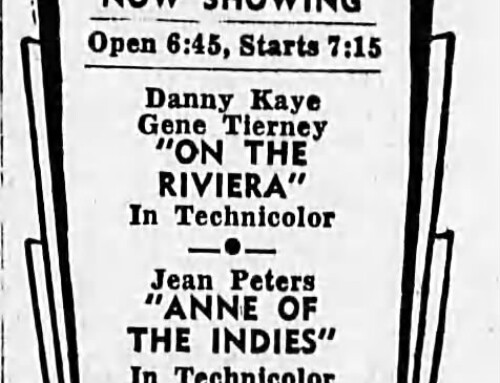
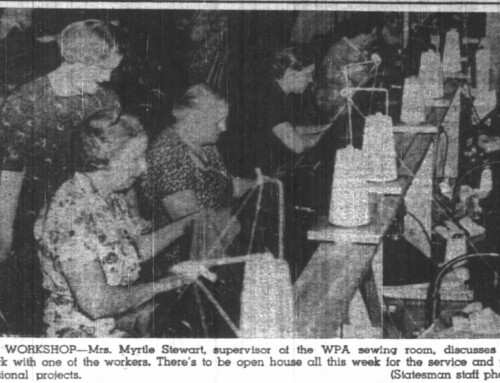
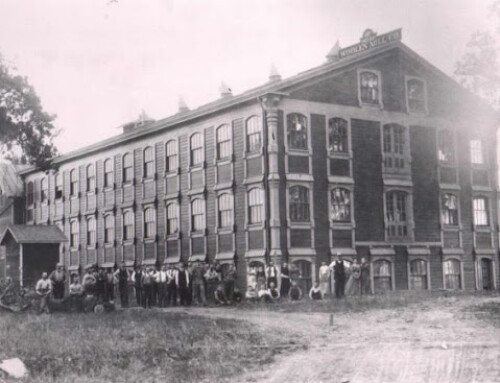
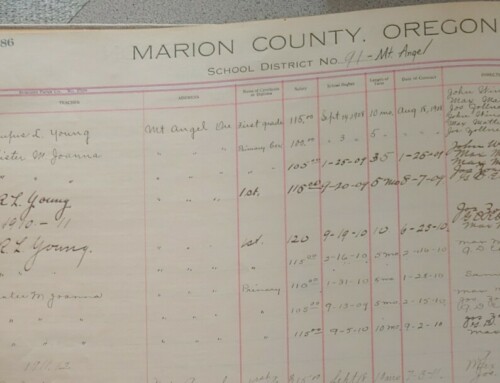
Leave A Comment